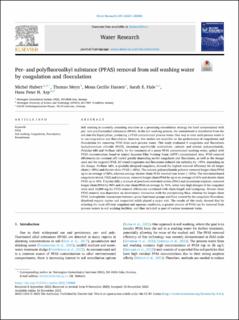| dc.description.abstract | Soil washing is currently attracting attention as a promising remediation strategy for land contaminated with per- and polyfluoroalkyl substances (PFAS). In the soil washing process, the contaminant is transferred from the soil into the liquid phase, producing a PFAS contaminated process water. One way to treat such process water is to use coagulation and flocculation; however, few studies are available on the performance of coagulation and flocculation for removing PFAS from such process water. This study evaluated 6 coagulants and flocculants (polyaluminium chloride (PACl), zirconium oxychloride octahydrate, cationic and anionic polyacrylamide, Polyclay 685 and Perfluor Ad®), for the treatment of a proxy PFAS contaminated washing water, spiked with PFAS concentrations found at typical Aqueous Film Forming Foam (AFFF) contaminated sites. PFAS removal efficiencies (at constant pH) varied greatly depending on the coagulants and flocculants, as well as the dosage used and the targeted PFAS. All tested coagulants and flocculants reduced the turbidity by >95%, depending on the dosage. Perfluor Ad®, a specially designed coagulant, showed the highest removal efficiency for all longer chain (>99%) and shorter chain PFAS (>68%). The cationic polyacrylamide polymer removed longer chain PFAS up to an average of 80%, whereas average shorter chain PFAS removal was lower (<30%). The two metal-based coagulants tested, PACl and zirconium, removed longer chain PFAS by up to an average of 61% and shorter chain PFAS up to 48%. Polyclay 685, a mixture of powdered activated carbon (PAC) and aluminium sulphate, removed longer chain PFAS by 90% and shorter chain PFAS on average by 76%, when very high dosages of the coagulant were used (2,000 mg/L). PFAS removal efficiencies correlated with chain length and headgroup. Shorter chain PFAS removal was dependent on electrostatic interaction with the precipitating flocs, whereas for longer chain PFAS, hydrophobic interactions between apolar functional groups and flocs created by the coagulant/flocculant, dissolved organic matter and suspended solids played a major role. The results of this study showed that by selecting the most efficient coagulant and aqueous conditions, a greater amount of PFAS can be removed from process waters in soil washing facilities, and thus included as part of various treatment trains. | en_US |

